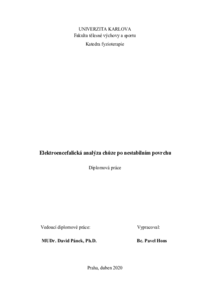EEG analýza chůze na nestabilním povrchu
EEG analysis of gait on an unstable surface
diplomová práce (OBHÁJENO)

Zobrazit/
Trvalý odkaz
http://hdl.handle.net/20.500.11956/118263Identifikátory
SIS: 199291
Kolekce
- Kvalifikační práce [9395]
Autor
Vedoucí práce
Oponent práce
Pavlů, Dagmar
Fakulta / součást
Fakulta tělesné výchovy a sportu
Obor
Fyzioterapie
Katedra / ústav / klinika
Fyzioterapie
Datum obhajoby
19. 6. 2020
Nakladatel
Univerzita Karlova, Fakulta tělesné výchovy a sportuJazyk
Čeština
Známka
Výborně
Klíčová slova (česky)
sLORETA, slackline, virtuální realita, zrcadlové neuronyKlíčová slova (anglicky)
mirror neurons, sLORETA, slackline, virtual realityElektroencefalická analýza chůze po nestabilním povrchu Cílem práce bylo porovnání změn elektrické aktivity intracerebrálních mozkových struktur s pomocí programu sLORETA mezi 1) klidovým stavem a chůzí po slackline klidovým stavem a chůzí po nalepeném tapu na zemi (groundline) a 3) mezi klidovým stavem a použití virtuální reality s projekcí chůze po slackline. Cílem bylo zjistit, které intracerebrální oblasti se při těchto aktivitách zapojují. u se zúčastnilo 10 zdravých osob, mužů i žen, ve věkovém rozmězí 18 - 30 let, průměrný věk byl 24 let. Experiment se skládal ze čtyř na sebe navazujících částí, u kterých bylo kromě první náhodně vybráno jejich pořadí. 1. klidové měření EEG s otevřenýma a zavřenýma očima (každá část 5 minut), 2. chůze po slackline (2 minuty), 3. chůze po groundline s imitací chůze po slackline (2 minuty), 4. pozorování videa s projekcí chůze po slackline z první osoby pomocí virtuální reality ve stoji na místě (2 minuty). V průběhu celého experimentu byla monitorována a zaznamenávána mozková aktivita. Získaný záznam byl následně vyhodnocen programem sLORETA, který posléze umožnil prostorové zobrazení aktivních mozkových částí v 3D Talairachově atlasu. halily statisticky významnou diferenci u všech tří porovnání párových skupin. Při porovnání chůze po slackline oproti klidovému stavu...
1 Abstract Title: EEG analysis of gait on an unstable surface Objectives: The aim of the thesis was comparison of changes of electrical activity of intercerebral brain structures using the programme sLORETA between 1) the state of rest and walk on slackline, 2) the state of rest and walk on groundline and 3) between the state of rest and projection of first-person virtual reality of walking on slackline; to find out which intracerebral areas are activated during these activities. Methods: 10 healthy participants took part in the test, 6 males and 4 females, between 18 and 30 years of age, 24 years of age on average. The experiment consisted of EEG gauging at rest with open/closed eyes (5 minutes each) and three other consequent parts in random order: 1. walk on slackline (2 minutes), 2. walk on groundline imitating walk on slackline (2 minutes), 3. watching a video with the first-person virtual reality projection of walking on slackline in basic position (2 minutes). During the whole experiment the brain activity was monitored and recorded by Wireless EEG Nicolet, EEG hat Waveguard Connect with 19 electrodes was used for collecting data by scalp EEG. The record was consequently assessed by sLORETA programme which created projection of active brain parts in 3D Talairach atlas. Results: Statistically...
